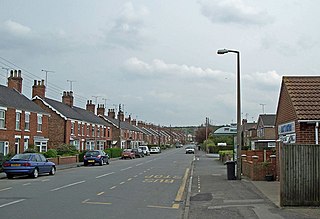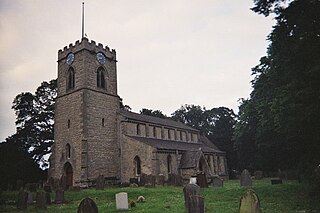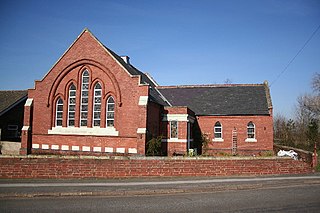
Brigg (/'brɪg/) is a market town in North Lincolnshire, England, with a population of 5,076 in the 2001 UK census, the population increased to 5,626 at the 2011 census. The town lies at the junction of the River Ancholme and east–west transport routes across northern Lincolnshire. As a formerly important local centre, the town's full name of Glanford Brigg is reflected in the surrounding area and local government district of the same name. The town's urban area includes the neighbouring hamlet of Scawby Brook.

West Lindsey is a local government district in Lincolnshire, England. Its council is based in Gainsborough, the district's largest town. The district also includes the towns of Caistor and Market Rasen, along with numerous villages and surrounding rural areas. The east of the district includes part of the Lincolnshire Wolds, a designated Area of Outstanding Natural Beauty.

The Parts of Lindsey are a traditional division of Lincolnshire, England, covering the northern part of the county. The Isle of Axholme, which is on the west side of the River Trent, has normally formed part of it. The district's name originated from the Kingdom of Lindsey of Anglo-Saxon times, whose territories were merged with that of Stamford to form Lincolnshire.
Lincolnshire, England derived from the merging of the territory of the ancient Kingdom of Lindsey with that controlled by the Danelaw borough of Stamford. For some time the entire county was called 'Lindsey', and it is recorded as such in the Domesday Book. Later, Lindsey was applied to only the northern core, around Lincoln; it was defined as one of the three 'Parts of Lincolnshire', along with Holland in the south-east and Kesteven in the south west.

Immingham is a town and civil parish in North East Lincolnshire, in Lincolnshire, England. It is situated on the south-west bank of the Humber Estuary, and is six miles northwest of Grimsby.

Caistor Grammar School is a selective school with academy status in the English town of Caistor in the county of Lincolnshire, England. The school was founded in 1630. It has since grown to be one of the most respected and highest performing schools in the East Midlands. The school has been awarded specialist sports and humanities status. The school attracts students from not only the town of Caistor, but also several surrounding settlements, including Grimsby, Brigg and Market Rasen. The current Headteacher is Shona Buck, who took up the position in September 2022, becoming the school's 28th head. Caistor Grammar was ranked first in Lincolnshire at both GCSE and A Level results in 2017. The school was ranked first at GCSE in 2018 and first at A level and GCSE in 2019. In the 2017 Times newspaper league tables it is in the top ten mixed state schools in the country. The school was named Sunday Times Parent Power State Secondary School of the Year 2018 in November 2017 and was the named the top school in the East Midlands by the Sunday Times in November 2019. It was also named school of the decade in the East Midlands in 2020.

Laceby is a village and civil parish in North East Lincolnshire, England. It is situated on the A46 road, just outside the western boundary of Grimsby. Laceby's population at the 2001 Census was 2,886, increasing to 3,259 at the 2011 Census. The village is noted for its parish church of St Margaret's, parts of which date to the 12th century.

Barnetby le Wold is a village and civil parish in North Lincolnshire, Lincolnshire, England, located between Brigg and Immingham. The village is also near Barton-upon-Humber. Barnetby railway station serves the village and Humberside Airport.

Scawby is a village and civil parish in North Lincolnshire, England. It is situated 2 miles (3 km) south-west from Brigg, and just east from the A15 road, and south from the M180 motorway. According to the 2001 Census, Scawby population was 2,277, reducing slightly to 2,243 at the 2011 census.

Cabourne is a hamlet and civil parish in the West Lindsey district of Lincolnshire, England. It is situated on the A46 road, and just over 1 mile (1.6 km) east from the town of Caistor. In 2021 the parish had a population of 81.
Caistor Yarborough Academy is a mixed 11–16 yrs secondary school based in the Lincolnshire market town of Caistor, England. The school was founded as Caistor Yarborough School on 18 October 1938, and celebrated its 75th anniversary in 2013. The school serves a large area of rural Lincolnshire, with a number of pupils travelling from outside the local area to attend the school, including pupils from Grimsby and Scunthorpe. It performs consistently well at GCSE.

Osgodby is a village and civil parish in the West Lindsey district of Lincolnshire, England. The population of the civil parish, including Kingerby, Kirkby and Usselby, and West Rasen in its own civil parish, was 660 at the 2011 census.

Searby is a village in the West Lindsey district of Lincolnshire, England, situated 4 miles (6.4 km) south-east from Brigg and 5 miles (8.0 km) north-east from Caistor. The village is in the civil parish of Searby cum Owmby, between the villages of Somerby and Grasby, and in the Lincolnshire Wolds, a designated Area of Outstanding Natural Beauty. Less than 1 mile (1.6 km) to the south is the parish hamlet of Owmby.

Croxby is a hamlet and former civil parish, now in the parish of Thoresway, in the West Lindsey district of Lincolnshire, England. It is situated approximately 5 miles (8.0 km) east from the town of Caistor. In 1931 the parish had a population of 77. On 1 April 1936 the parish was abolished and merged with Thoresway.

East Barkwith is a village and civil parish in the East Lindsey district of Lincolnshire, England. It is situated on the A157, and approximately 13 miles (21 km) north-east from the city of Lincoln,

Brackenborough is a hamlet in the civil parish of Brackenborough with Little Grimsby, in the East Lindsey district of Lincolnshire, England. It is situated approximately 2 miles (3 km) north from the town of Louth, and lies in the Lincolnshire Wolds, a designated Area of Outstanding Natural Beauty. In 1971 the parish had a population of 48. On 1 April 1987 the parish was abolished and merged with Little Grimsby to form "Brackenborough with Little Grimsby".

Knaith is a village and civil parish about 3 miles (5 km) south of the town of Gainsborough in the West Lindsey district of Lincolnshire, England. The population of the civil parish at the 2011 census was 335.

Market Stainton is a village and civil parish in the East Lindsey district of Lincolnshire, England. It is situated approximately 7 miles (11 km) north from the market town of Horncastle.

Owmby is a hamlet in the civil parish of Searby cum Owmby, in the West Lindsey district of Lincolnshire, England. It is less than 1 mile (1.6 km) south from the A1084 road, 3 miles (5 km) north-west from Caistor, 4 miles (6 km) south-east from Brigg, and in the Lincolnshire Wolds, a designated Area of Outstanding Natural Beauty. The parish village of Searby is less than 1 mile to the north-east.

Thornton le Moor is a village in the civil parish of Owersby, in the West Lindsey district of Lincolnshire, England, situated approximately 5 miles (8 km) south-west from the town of Caistor. In 1931 the parish had a population of 70. On 1 April 1936 the parish was abolished and merged with Owersby.



















